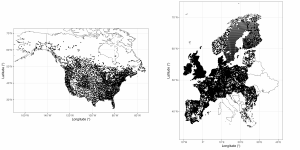New Research Reveals How Non-Native Songbirds Adapt in Surprising Ways Across Continents
October 31, 2025
A major international study led by Dr Kristin Davis, a postdoctoral researcher at UC Berkeley, which also utilised the PECBMS data, has uncovered patterns in how two globally widespread songbirds—the European Starling (Sturnus vulgaris) and the House Sparrow (Passer domesticus)—respond to their environments in native versus non-native ranges.

House Sparrow abundance increased more with grassland in its native distribution in Europe versus its non-native distribution in North America. Photo by Dana Zelená, Flickr CSO
Published in Diversity and Distributions, the study analysed over 400,000 bird observations across 22 years and 28 countries in North America and Europe to test the long-standing niche conservatism hypothesis, which assumes that species prefer a stable ecological niche, or consistent environmental conditions, where individuals can survive and reproduce, across space and time. The findings challenge this assumption and offer new directions for ecological modelling and conservation.

Map: Locations of focal sites in North America (n = 4,654; left) and Europe (n = 24,086; right) for both European starling and house sparrow from which data were used to explore differences in abundance responses to the environment in the species’ native European and non-native North American distributions (maps not to scale).
Key Findings:
- Ecological Boundaries Hold, But Behaviour Shifts: While both species’ ecological niches remained largely stable, the birds’ abundance responses to temperature and land cover varied significantly between Europe and North America.
- Niche Unfilling in New Territory: Both species avoided wetter habitats in North America that they commonly occupy in Europe, suggesting available but unused ecological space – a phenomenon known as niche unfilling.
- Local Adaptation and Flexibility: Differences in environmental associations point to behavioural plasticity, local adaptation, and possibly genetic divergence in non-native populations.
Why It Matters
These findings have profound implications for species distribution modelling, invasive species management, and climate change forecasting. The study advocates for integrating abundance data into ecological models to predict species responses in novel environments better.
“To improve assessments and predictions of species’ invasion risk or sensitivity to global environmental change, I hope to see the study of niche conservatism continue to expand to explore changes at both the edges of and within niche boundaries,” Dr Davis said.
About the Study
This research, which formed a core part of Dr Davis´s dissertation at Colorado State University, was made possible thanks to the long-standing commitment of volunteers, scientists, and national agencies involved in continental-scale bird monitoring. A key component of the study relied on data from the Pan-European Common Bird Monitoring Scheme (PECBMS), which provided the European bird population trends essential for cross-continental analysis. The study also relied on data from the North American Breeding Bird Survey, a long-term effort in which volunteers collect and U.S. federal scientists process and make publicly available annual data on bird abundance across North America.
Dr Davis collaborated closely with international experts and PECBMS coordinators, including Dr Henning Heldbjerg (Aarhus University, Denmark) and Dr Henrik Smith (Lund University, Sweden), who contributed deep ecological knowledge of the species in their native European habitats. Dr Anna Gamero, PECBMS research officer at the Czech Society for Ornithology, played a vital role in guiding the use and interpretation of PECBMS data, ensuring scientific rigour and regional relevance.
“This collaboration highlights the value of PECBMS as a cornerstone for global ecological research,“ Dr Gamero concluded. “It reinforces the importance of long-term monitoring in understanding how species respond to environmental change.“
The paper, Non‐Native Bird Populations Respond Differently to Their Environment and Exhibit Shifts in Ecological Niche Limits Across Continents, is available online via Wiley at https://doi.org/10.1111/ddi.70100.
Read also the blog post Kristin Davis Uncovers Nuanced Songbird Population Responses Between North America & Europe by The Eric and Wendy Schmidt Center for Data Science and Environment at Berkeley.
Media Contact:
Dr. Kristin Davis
Postdoctoral Researcher, UC Berkeley
Email: kpdavis@berkeley.edu
